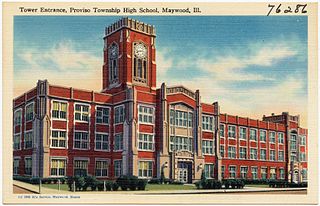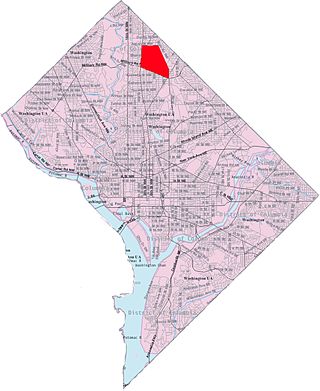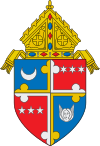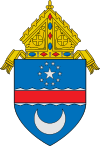
Takoma Park is a city in Montgomery County, Maryland, United States. It is a suburb of Washington, and part of the Washington metropolitan area. Founded in 1883 and incorporated in 1890, Takoma Park, informally called "Azalea City", is a Tree City USA and a nuclear-free zone. A planned commuter suburb, it is situated along the Metropolitan Branch of the historic Baltimore and Ohio Railroad, just northeast of Washington, D.C., and it shares a border and history with the adjacent Washington, D.C. neighborhood of Takoma. It is governed by an elected mayor and six elected councilmembers, who form the city council, and an appointed city manager, under a council-manager style of government. The city's population was 17,629 at the 2020 census.

Chillum is an unincorporated area and census-designated place in Prince George's County, Maryland, United States, bordering Washington, D.C. and Montgomery County.

Langley Park is an unincorporated area and census-designated place (CDP) in Prince George's County, Maryland, United States. It is located inside the Capital Beltway, on the northwest edge of Prince George's County, bordering Montgomery County. Per the 2020 census, the population was 20,126.

Barrie School is a progressive independent school for students age 12 months through Grade 12 located in an unincorporated area of Montgomery County, Maryland, outside of Washington, D.C. The school is within the Glenmont census designated place, has a Silver Spring postal address, and is in close proximity to Layhill. Barrie School is a nonprofit school with 501(c)(3) status.

Griffith Stadium stood in Washington, D.C., from 1911 to 1965, between Georgia Avenue and 5th Street, and between W Street and Florida Avenue NW.

Shepherd Park is a neighborhood in the northwest quadrant of Washington, D.C. In the years following World War II, restrictive covenants which had prevented Jews and African Americans from purchasing homes in the neighborhood were no longer enforced, and the neighborhood became largely Jewish and African American. Over the past 40 years, the Jewish population of the neighborhood has declined but the neighborhood has continued to support a thriving upper and middle class African American community. The Shepherd Park Citizens Association and Neighbors Inc. led efforts to stem white flight from the neighborhood in the 1960s and 1970s, and it has remained a continuously integrated neighborhood, with very active and inclusive civic groups.
Frank W. Ballou Senior High School is a public school located in Washington, D.C., United States. Ballou is a part of the District of Columbia Public Schools. The principal is Willie Jackson.

The John Philip Sousa Bridge, also known as the Sousa Bridge and the Pennsylvania Avenue Bridge, is a continuous steel plate girder bridge that carries Pennsylvania Avenue SE across the Anacostia River in Washington, D.C., in the United States. The bridge is named for famous United States Marine Band conductor and composer John Philip Sousa, who grew up near the bridge's northwestern terminus.

Wilbert Tucker Woodson High School, commonly known as W.T. Woodson High School or simply Woodson, is a high school located in Fairfax County, Virginia, in the east end of the city of Fairfax, opposite the shopping center on Main Street.

Proviso East High School is a public secondary school in Maywood, Illinois which serves the educational needs of Maywood and three other villages within Proviso Township, Cook County, Illinois: Broadview, Forest Park and Melrose Park. It is the original campus of Proviso Township High Schools District 209. Prior to being split into East and Proviso West High School in 1958, East was known as Proviso Township High School. The school is located at the intersection of Madison Street and First Avenue.

Kingman Park is a residential neighborhood in the Northeast quadrant of Washington, D.C., the capital city of the United States. Kingman Park's boundaries are 15th Street NE to the west; C Street SE to the south; Benning Road to the north; and Anacostia Park to the east. The neighborhood is composed primarily of two-story brick rowhouses. Kingman Park is named after Brigadier General Dan Christie Kingman, the former head of the United States Army Corps of Engineers.

Proviso West High School (PWHS) is a public high school located in Hillside, Illinois, United States. It is a part of Proviso Township High Schools District 209, and was opened in 1958. Its sister schools are Proviso East High School and Proviso Mathematics and Science Academy.

De La Salle Institute is a private, Catholic, coeducational secondary school run by the Institute of the Brothers of the Christian Schools in the Bronzeville neighborhood on the South Side of Chicago, Illinois, United States. It was founded by Brother Adjutor of the De La Salle Brothers in 1889.

Manor Park is a neighborhood in Ward 4 of northwest Washington, D.C. The National Capital Planning Commission 1967 "District Communities" map indicates this neighborhood is roughly bounded between 8th Street NW to the west, North Capitol Street NW, Blair Road NW, and the Washington Metropolitan Area Red Line train tracks to the east, Rittenhouse Street NW to the north, and Missouri Avenue NW to the south. Manor Park borders the adjacent neighborhoods of Takoma Park, Brightwood, and Brightwood Park in NW Washington D.C. and also borders the Riggs Park neighborhood in NE Washington D.C. In 1940, the Manor Park Citizens Association deemed the boundaries to be Eighth Street, Whittier Street, North Capitol Street, and Concord Street.

The District of Columbia Interscholastic Athletic Association (DCIAA) is the public high school athletic league in Washington, D.C. The league was founded in 1958. The original high school conference for D.C. schools was the Inter-High School Athletic Association, formed around 1896. That organization was segregated, and black schools in the District formed their own athletic association. The Inter-High League was renamed the DCIAA in 1989 to bring the District of Columbia in line with other states with interscholastic athletic programs. The DCIAA offers sports on the elementary, middle and high school levels.
Fort Stevens Ridge is a neighborhood in Northwest Washington, D.C. built during the 1920s. The neighborhood comprises about 50 acres (0.20 km2) and is very roughly bounded by Peabody Street, Fifth Street, Underwood Street, and Ninth Street. As of the 2010 census, the neighborhood had 2,597 residents. It was named for nearby Fort Stevens, a Civil War-era fort used to defend the nation's capital from invasion by Confederate soldiers.

Langston Golf Course is an 18-hole golf course in Washington, D.C., established in 1939. It was named for John Mercer Langston, an African American who was the first dean of the Howard University School of Law, the first president of Virginia Normal and Collegiate Institute, and the first African American elected to the United States Congressas a Republican from Virginia. It was the second racially desegregated golf course in the District of Columbia, and in 1991 its first nine holes were added to the National Register of Historic Places.

J.G. Whittier Elementary School is a public elementary school located in the Northwest quadrant of the District of Columbia.

Brightwood Education Campus is a public school located in the Northwest quadrant of the District of Columbia.
Brookland Stadium, or Killion Field, was the athletic field for Catholic University in Brookland, Washington, D.C. from 1924 to 1985. It was located on the main campus of The Catholic University of America, next to Brookland Gymnasium, in the area now occupied by the Columbus School of Law and the Law School Lawn.




















